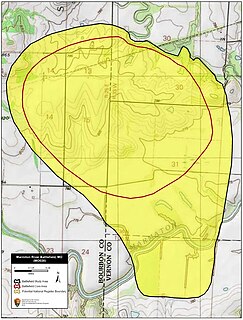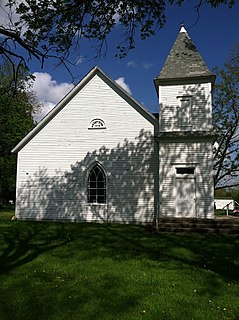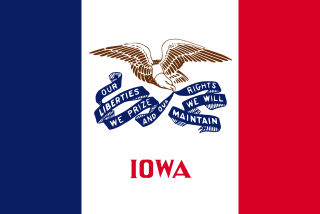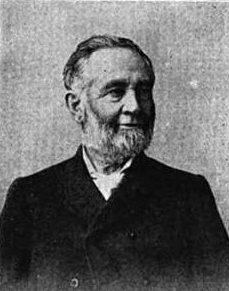
The Battle of Wilson's Creek, also known as the Battle of Oak Hills, was the first major battle of the Trans-Mississippi Theater of the American Civil War. It was fought on August 10, 1861, near Springfield, Missouri. Missouri was officially a neutral state, but its governor, Claiborne Fox Jackson, supported the South and secretly collaborated with Confederate troops.
The Battle of Glasgow was fought on October 15, 1864, in and near Glasgow, Missouri, as part of Price's Missouri Expedition during the American Civil War. In late 1864, the Confederate leadership in the Trans-Mississippi Theater planned a campaign into the state of Missouri, in hopes of drawing Union troops from more important theaters east of the Mississippi River. Major General Sterling Price commanded the expedition, and initially hoped to capture St. Louis, although an early defeat at the Battle of Pilot Knob led him to abandon this plan. After the strength of the Union garrison at Jefferson City convinced Price to cancel a planned attempt to capture the place, he led his army into the pro-Confederate region of Little Dixie, where recruiting efforts were successful.

The First Battle of Independence was a minor engagement of the American Civil War, occurring on August 11, 1862, in the city of Independence, located in Jackson County, Missouri. Its result was a Confederate victory, continuing the Southern domination of the Jackson County area for a few days while the recruiters completed their work.

The Battle of Marmiton River, also known as Shiloh Creek or Charlot's Farm, occurred on October 25, 1864, in Vernon County, Missouri during the American Civil War. Major General Sterling Price of the Confederate States Army commenced an expedition into Missouri in September 1864, with hopes of challenging Union control of the state. After a defeat at the Battle of Westport on October 23, Price began to retreat south, and suffered a serious defeat at the Battle of Mine Creek early on October 25. The afternoon of the 25th, Price's wagon train became stalled at the crossing of the Marmaton River in western Missouri. A delaying force led by Brigadier General Joseph O. Shelby attempted to hold off Union cavalry commanded by Brigadier General John McNeil and Lieutenant Colonel Frederick W. Benteen. Shelby was unable to drive off the Union force, although fatigue of the Union cavalry's horses prevented close-quarters action. At nightfall, the Confederates disengaged and destroyed much of their wagon train. Price was again defeated on October 28 at the Second Battle of Newtonia, and the Confederate retreat continued until the survivors reached Texas in early December.

The Battle of Mount Zion Church was fought on December 28, 1861, in Boone County, near Mount Zion Church, during the American Civil War. The resulting Union victory here and elsewhere in central Missouri ended Confederate recruiting activities in the region and pushed conventional Confederate forces out of the area until the desperate fall 1864 invasion by General Sterling Price and his Missouri State Guard.
The Battle of Roan's Tan Yard, also known as the Battle of Silver Creek, was a minor battle fought during the American Civil War on January 8, 1862, in Randolph County, Missouri. After back-and-forth operations throughout 1861, the pro-Confederate Missouri State Guard under the command of Sterling Price had been confined to southwestern Missouri. In December 1861, Price authorized recruiting and raiding activities in the central portion of the state, with the North Missouri Railroad being a major target. In January 1862, Major W. M. G. Torrence of the Union Army located a Missouri State Guard base in Randolph County and attacked it on January 8 with elements of four cavalry regiments. The camp, which was commanded by Colonel John A. Poindexter, put up little resistance and was soon overrun. Large quantities of supplies were captured in the abandoned camp, which was destroyed. The action at Roan's Tan Yard, along with a Missouri State Guard defeat at the Battle of Mount Zion Church the preceding December, led to a decrease in pro-Confederate activity in central Missouri.

Price's Missouri Expedition, also known as Price's Raid or Price's Missouri Raid, was an unsuccessful Confederate cavalry raid through Arkansas, Missouri, and Kansas in the Trans-Mississippi Theater of the American Civil War. Led by Confederate Major-General Sterling Price, the campaign's intention was to recapture Missouri and renew the Confederate initiative in the larger conflict.

The Battle of Honey Springs, also known as the Affair at Elk Creek, on July 17, 1863, was an American Civil War engagement and an important victory for Union forces in their efforts to gain control of the Indian Territory. It was the largest confrontation between Union and Confederate forces in the area that would eventually become Oklahoma. The engagement was also unique in the fact that white soldiers were the minority in both fighting forces. Native Americans made up a significant portion of each of the opposing armies and the Union force contained African-American units.
Joseph Chrisman Porter was a Confederate officer in the American Civil War, a key leader in the guerrilla campaigns in northern Missouri, and a figure of controversy. The main source for his history, Joseph A. Mudd is clearly an apologist; his opponents take a less charitable view of him, and his chief adversary, Union Colonel John McNeil, regarded him simply as a bushwacker and traitor, though his service under General John S. Marmaduke in the Springfield campaign and following clearly shows he was regarded as a regular officer by the Confederacy.
The Centralia Massacre was an incident during the American Civil War in which 24 unarmed Union soldiers were captured and executed in Centralia, Missouri on September 27, 1864 by a band led by the pro-Confederate guerrilla leader William T. Anderson. Future outlaw Jesse James was among the guerrillas.

The 1st Iowa Cavalry Regiment was a cavalry regiment that served in the Union Army during the American Civil War.
The Enrolled Missouri Militia was a state militia organization of Missouri in 1862 during the American Civil War. It was a part-time force whose primary purpose was to serve as garrison and infrastructure guards, both to augment the Unionist Missouri State Militia in defense versus raids and to free the Missouri State Militia for offensive operations versus Confederate guerrillas and recruiters.

Odon Guitar was a general in the Union Missouri State Militia during the American Civil War. He was noted for his successful campaign against Joseph C. Porter and John A. Poindexter's recruiting commands in northern Missouri.

The Battle of Moore's Mill was an American Civil War battle that took place in Central Missouri on July 28, 1862 along Auxvasse Creek near modern-day Calwood. This engagement, the Battle of Kirksville a week later, and the Battle of Compton's Ferry would drive the main Southern recruiters from northern Missouri. The Moore's Mill Battlefield was added to the National Register of Historic Places in 2015.

During the American Civil War, most of what is now the U.S. state of Oklahoma was designated as the Indian Territory. It served as an unorganized region that had been set aside specifically for Native American tribes and was occupied mostly by tribes which had been removed from their ancestral lands in the Southeastern United States following the Indian Removal Act of 1830. As part of the Trans-Mississippi Theater, the Indian Territory was the scene of numerous skirmishes and seven officially recognized battles involving both Native American units allied with the Confederate States of America and Native Americans loyal to the United States government, as well as other Union and Confederate troops.
John A. Poindexter was a colonel in the Confederate Army during the American Civil War. He and Joseph C. Porter were the primary recruiting commanders in northern Missouri during 1862.
The 2nd Missouri Cavalry Regiment, also known officially as Merrill's Horse, was a cavalry regiment that served in the Union Army during the American Civil War. The regiment was one of only a handful of Missouri regiments to be officially named as well as numbered.
The Battle of Yellow Creek, also known as Skirmish at Yellow Creek, was an action during the American Civil War, occurring August 13, 1862, along the Yellow Creek in Chariton County, Missouri.
The action at Ashley's Station was a large engagement fought between Confederate States Army cavalry raiders under Brigadier General Joseph O. Shelby and Union Army garrison forces under the overall command of Brigadier General Christopher Columbus Andrews and immediate commands of Colonel Greenville M. Mitchell and Colonel Washington F. Geiger in Prairie County, Arkansas on August 24, 1864 during the American Civil War.
The 13th Missouri Cavalry Regiment was a cavalry unit that served in the Confederate States Army during the American Civil War. In early April 1863, Captain Robert C. Wood, aide-de-camp to Confederate Major General Sterling Price, was detached to form an artillery unit from some of the men of Price's escort. Wood continued recruiting for the unit, which was armed with four Williams guns, and grew to 275 men by the end of September. The next month, the unit fought in the Battle of Pine Bluff, driving back Union Army troops into a barricaded defensive position, from which the Union soldiers could not be dislodged. By November, the unit, which was known as Wood's Missouri Cavalry Battalion, had grown to 400 men but no longer had the Williams guns. In April 1864, Wood's battalion, which was also known as the 14th Missouri Cavalry Battalion, played a minor role in the defeat of a Union foraging party in the Battle of Poison Spring, before spending the summer of 1864 at Princeton, Arkansas. In September, the unit joined Price's Raid into the state of Missouri, but their assault during the Battle of Pilot Knob failed to capture Fort Davidson.














